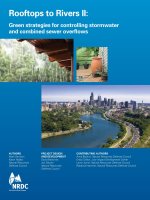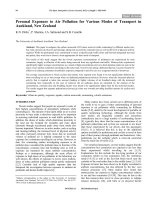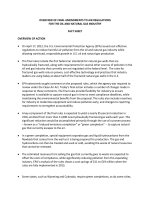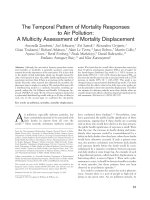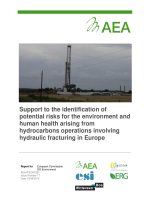OVERVIEW OF FINAL AMENDMENTS TO AIR REGULATIONS FOR THE OIL AND NATURAL GAS INDUSTRY ppt
Bạn đang xem bản rút gọn của tài liệu. Xem và tải ngay bản đầy đủ của tài liệu tại đây (354.18 KB, 5 trang )
OVERVIEW OF FINAL AMENDMENTS TO AIR REGULATIONS
FOR THE OIL AND NATURAL GAS INDUSTRY
FACT SHEET
OVERVIEW OF ACTION
On April 17, 2012, the U.S. Environmental Protection Agency (EPA) issued cost-effective
regulations to reduce harmful air pollution from the oil and natural gas industry while
allowing continued, responsible growth in U.S. oil and natural gas production.
The final rules include the first federal air standards for natural gas wells that are
hydraulically fractured, along with requirements for several other sources of pollution in the
oil and gas industry that currently are not regulated at the federal level. The rules for
fractured gas wells rely on proven, cost-effective technology and practices that industry
leaders are using today at about half of the fractured natural gas wells in the U.S.
EPA extensively sought comment on the proposed rules, which the agency was required to
review under the Clean Air Act. Today’s final action includes a number of changes made in
response to those comments. The final rules provide flexibility for industry to ensure
equipment is available to capture natural gas in time to meet compliance deadlines, while
maintaining the environmental benefits from the proposal. The rules also include incentives
for industry to modernize equipment and reduce pollution early, and changes to reporting
requirements to strengthen accountability.
A key component of the final rules is expected to yield a nearly 95 percent reduction in
VOCs emitted from more than 11,000 new hydraulically fractured gas wells each year. This
significant reduction would be accomplished primarily through the use of a proven process
– known as a “reduced emissions completion” or “green completion” to capture natural
gas that currently escapes to the air.
In a green completion, special equipment separates gas and liquid hydrocarbons from the
flowback that comes from the well as it is being prepared for production. The gas and
hydrocarbons can then be treated and used or sold, avoiding the waste of natural resources
that cannot be renewed.
The estimated revenues from selling the gas that currently goes to waste are expected to
offset the costs of compliance, while significantly reducing pollution from this expanding
industry. EPA’s analysis of the rules shows a cost savings of $11 to $19 million when the
rules are fully implemented in 2015.
Some states, such as Wyoming and Colorado, require green completions, as do some cities,
2
including Fort Worth and Southlake, Texas. In addition, data provided to EPA’s Natural Gas
STAR program show that a number of companies are using green completions voluntarily.
Today’s rule builds on the emission reductions these leaders have taken, leveling the
playing field across the industry and ensuring this smart environmental and business
practice is used in all states where gas wells are fractured.
POLLUTION REDUCTION, CONTINUED NATURAL GAS PRODUCTION
The VOC emission reductions from wells, combined with reductions from storage tanks and
other equipment, are expected to help reduce ground-level ozone in areas where oil and
gas production occurs. In addition, the reductions would yield a significant environmental
co-benefit by reducing methane emissions from new and modified wells. Methane, the
primary constituent of natural gas, is a potent greenhouse gas – more than 20 times as
potent as carbon dioxide when emitted directly to the atmosphere. Oil and natural gas
production and processing accounts for nearly 40 percent of all U.S. methane emissions,
making the industry the nation’s single largest methane source.
Today’s final rules also would protect against potential cancer risks from emissions of
several air toxics, including benzene.
EPA estimates the following combined annual emission reductions when the rules are fully
implemented :
o VOCs: 190,000 to 290,000 tons;
o Air Toxics: 12,000 to 20.000 tons; and
o Methane 1.0 to 1.7 million short tons [about 19 to 33 million tonnes of CO2
equivalent (CO2e)]
Today’s action continues EPA’s efforts to support responsible oil and natural gas exploration
and production that protect public health and the environment. In 2011, for example, the
Agency signed a memorandum of understanding with the departments of Interior and
Agriculture establishing a common process for the agencies to follow in analyzing the
potential air quality impacts of proposed oil and gas activities on federally managed public
lands. The collaborative approach in the agreement will provide increased certainty, clarity
and transparency about requirements on public lands.
To learn more about specific requirements of today’s rules visit:
www.epa.gov/airquality/oilandgas
COSTS AND BENEFITS
Today’s cost-effective rules will yield significant reductions in air pollution while offsetting
the costs to industry. EPA estimates the combined rules will yield a cost savings of $11 to
$19 million in 2015, because the value of natural gas and condensate that will be recovered
and sold will offset costs.
3
The VOCs and air toxics reductions in the rules are expected to improve outdoor air quality,
protect against cancer risk from air toxics emissions and reduce health effects associated
with exposure to ground-level ozone (smog). Exposure to ozone is linked to increased
asthma attacks, hospital admissions and emergency room visits, and premature death. EPA
was unable to model health benefit estimates for the rule, due to uncertainties about
future locations of oil and gas emissions. Air quality changes associated with air toxics and
VOC reductions can be highly localized.
Today’s rules also would yield significant reductions in methane, a potent greenhouse gas.
EPA’s Regulatory Impact Analysis for the rule estimates the value of the climate co-benefits
that would result from this reduction at $440 million annually by 2015. This includes the
value of climate-related benefits such as avoided health impacts, crop damage and damage
to coastal properties.
AIR EMISSIONS FROM OIL AND GAS PRODUCTION IN THE U.S.
In 2009, about 1.1 million wells were producing oil and natural gas in the United States. The
wells are located in many areas of the country, including both urban and rural areas.
The majority of new gas wells drilled today use a process known as hydraulic fracturing or
“fracking.” In this process, a mixture of water, chemicals and a “proppant” (usually sand) is
pumped into a well at extremely high pressures to fracture rock and allow natural gas to
escape. An estimated 11,400 new wells are fractured each year; EPA estimates another
1,400 existing wells are re-fractured to stimulate production or to produce natural gas from
a different production zone.
The gas these wells produce goes to gathering and boosting stations that take it to
processing plants. These plants remove contaminants to make the gas ready for the
pipelines that deliver it to commercial, industrial and residential customers. Transmission
compression stations help move the gas through 1.5 million miles of natural gas pipelines
across the United States.
The oil and gas industry is a significant source of VOCs, which contribute to the formation of
ground-level ozone (smog). Data provided to EPA’s Natural Gas STAR Program show that
some of the largest air emissions in the natural gas industry occur as natural gas wells that
have been fractured are being prepared for production. During a stage of well completion
known as “flowback,” fracturing fluids, water, and reservoir gas come to the surface at a
high velocity and volume. This mixture includes a high volume of VOCs and methane, along
with air toxics such as benzene, ethylbenzene and n-hexane. The typical flowback process
lasts from three to 10 days. Pollution also is emitted from other processes and equipment in
the industry that prepare gas for sale and that assist in moving it through pipelines.
BACKGROUND
4
Today’s final action will cut emissions of smog-forming volatile organic compound (VOC)
emissions and air toxics from several segments of the oil and gas industry. The final rules
are the result of the review of four air regulations for the oil and natural gas industry
required by the Clean Air Act: a new source performance standard for VOCs; a new source
performance standard for sulfur dioxide; an air toxics standard for major sources of oil and
natural gas production; and an air toxics standard for major sources of natural gas
transmission and storage.
The Clean Air Act requires EPA to set new source performance standards (NSPS) for
industrial categories that cause, or significantly contribute to, air pollution that may
endanger public health or welfare. EPA is required to review these standards every eight
years. The existing NSPS – for VOCs and SO2 – were issued in 1985.
EPA also must set standards for emissions of air toxics, also called hazardous air pollutants.
Air toxics are pollutants known or suspected of causing cancer and other serious health
effects. EPA must review conduct a residual risk review of these standards once time, eight
years after the standard issued. The agency must conduct technology reviews of these
standards every eight years.
EPA’s existing air toxics standards for oil and natural gas production, and the standards for
natural gas transmission and storage were issued in 1999.
Litigation
In January 2009, WildEarth Guardians and the San Juan Citizens Alliance sued EPA, alleging
that the Agency had failed to review the new source performance standards and the major
source air toxic standards for the oil and natural gas industry.
In February 2010, the U.S. District Court for the District of Columbia issued a consent decree
that requires EPA to take actions related to the review of these standards. EPA issued the
proposed rule July 28, 2011. The consent decree, which was recently revised, required that
EPA take final action by April 17, 2012.
Public comment
EPA held two public meetings as it was developing the rules and three public hearings on
the proposal. The agency received more than 156,000 comments on the proposal.
• EPA’s Natural Gas STAR program has been working with U.S. oil and gas companies since
1993 to adopt proven, cost-effective technologies and practices that improve operational
efficiency and reduce methane emissions. Many Gas STAR partners already are using the
green completions that EPA is now requiring across the industry. For more information on
EPA’s Natural Gas STAR program, visit
5
• Additional information about hydraulic fracturing and EPA’s work is available at
FOR MORE INFORMATION ABOUT TODAY’S ACTION:
• The rule and other background information are posted at
Information also is available at EPA’s electronic
public docket and comment system (,) using Docket ID Number
EPA-HQ-OAR-2010-0505.
• The rule and materials also are available in hard copy at the EPA Docket Center’s Public
Reading Room, room 3334 in the EPA West Building, located at 1301 Constitution Avenue,
NW, Washington, DC. Hours of operation are 8:30 a.m. to 4:30 p.m. eastern time, Monday
through Friday, excluding federal holidays.
• Visitors are required to show photographic identification, pass through a metal detector,
and sign the EPA visitor log. All visitor materials will be processed through an X-ray machine
as well. Visitors will be provided a badge that must be visible at all times



